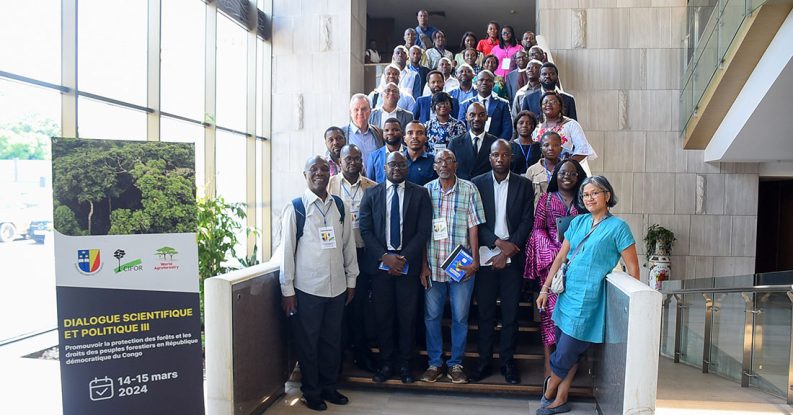In the Democratic Republic of Congo (DRC), mining is a key consideration in the fight to preserve forests – whilst maintaining the livelihoods of the people that call them home.
It’s not just about the areas felled directly to dig up the dirt. Every hectare of deforestation caused by mining leads to an additional 26 hectares in other land uses such as farming and settlements. And while industrial-scale mining is often most visibly concerning, its artisanal counterpart also poses environmental challenges.
There are about 2,500 artisanal mining sites, and about 350,000 miners, in eastern DRC. Between 2001 and 2020, a total of 261 new mines were opened. About 32 percent of households in the region are involved in the artisanal mining sector. Of those, 59 percent use the activity as their principal means of subsistence, while 41 percent use it to complement other sources of income.
“Artisanal mining is a major driver of deforestation,” explained Malte Ladewig, a doctoral candidate at the Norwegian University of Life Sciences (NMBU), during a two-day science and policy dialogue on 14-15 March 2024.
“Yet it also plays an important role in the livelihoods of millions of people in the eastern DRC, where mining households are less susceptible to food insecurity,” he said. “It is important to remember these people when addressing the many challenges associated with the artisanal mining sector.”
The session, the sixth and last of a series, formed part of a project on forest protection under the Global Comparative Study (GCS) REDD+ programme, whose DRC component is jointly run by the Center for International Forestry Research and World Agroforestry (CIFOR-ICRAF) and the University of Kinshasa (UNIKIN).
The hybrid online and in-person event brought together academics, researchers, government officials, donors, civil society actors, young people, private sector representatives, and other stakeholders to align research to the country’s needs, policies and targets.
Forest carbon – and communities
In recognition of the global importance of DRC’s forest estate, the last two years have seen a strong increase in the number of REDD+ projects in the country – from 18 in October 2022 to 27 in March 2024 – and as these proliferate, there’s increasing awareness of the importance of community participation.
“Recent projects are more conscious of including local communities and governments as stakeholders or partners in their project documents,” said CIFOR-ICRAF scientist Stibniati Atmadja, “and this is an initiative which should be encouraged.”
But Willy Loyombo, an expert on social forestry and REDD+ issues, advised continued caution. “While the implementation of REDD+ and the related carbon market offers development opportunities for forest-dwelling communities,” he said, “it at the same time entails a large number of risks that could lead to their land rights being ignored or restricted.”
Loyombo suggested that careful analysis is required before embarking communities on this complex process. “The loss of access to resources and the sedentarization of agriculture curtails the size of the communities’ arable land,” he said.
“Even if the communities are not evicted, this is tantamount to slavery, since they live on the land but are subject to a regime that prevents them from frequenting certain parts of their forests and, above all, from cultivating primary forests with high potential for agricultural production.”
Future focus
André Kashikisha presented on behalf of Augustin M. Mpoyi, a senior technical adviser at the Council for Environmental Defence through Legality and Traceability (CODELT), stating that one of the challenges for future forestry policy in DRC will be to ensure a qualitative consultative process.
“An appropriate methodology for mobilizing stakeholders should be designed and implemented,” he said. “In addition, the interests, fears, demands, observations and contributions of the stakeholders must be integrated in policies.”
He also cited the need to develop tools to facilitate consultation and data collection, and to make sure that the feedback of products such as diagnostic reports and draft policies are shared with relevant stakeholders.
“The Congolese state, as an institution, has a number of major challenges to meet for the benefit of its people,” surmised Jérémie Abozo, legal adviser at UNIKIN’s rectorate. “The Congo has a vast expanse of forest, but DRC as a country doesn’t enjoy the full benefits of these forests.”
As the CIFOR-UNIKIN project comes to an end, CIFOR-ICRAF’s chief operating officer Robert Nasi said that “what is important is to reflect on the future beyond this current study, and how this country – which represents 60 percent of the Congo Basin forests – can continue to have an effective role in mitigation and adaptation to climate change, whilst improving the living conditions of the population. This is the essential issue: how to mix the goat and the cabbage to have the best of both.”

Participants in the science and policy dialogue. Photo by Ntina Munoki Anta and Lutho Lemisa Christian/CIFOR-ICRAF
We want you to share Forests News content, which is licensed under Creative Commons Attribution-NonCommercial-ShareAlike 4.0 International (CC BY-NC-SA 4.0). This means you are free to redistribute our material for non-commercial purposes. All we ask is that you give Forests News appropriate credit and link to the original Forests News content, indicate if changes were made, and distribute your contributions under the same Creative Commons license. You must notify Forests News if you repost, reprint or reuse our materials by contacting forestsnews@cifor-icraf.org.
